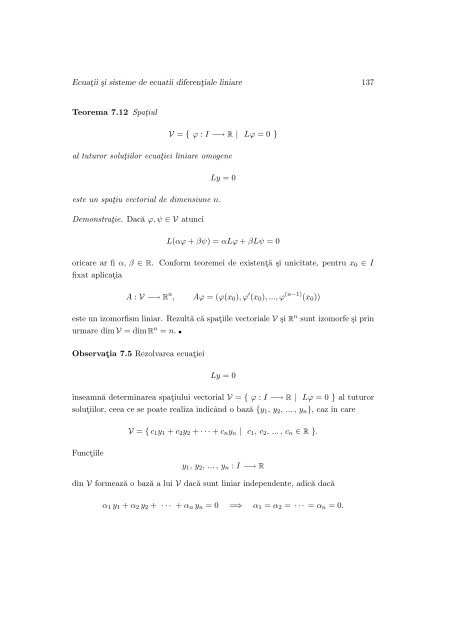You also want an ePaper? Increase the reach of your titles
YUMPU automatically turns print PDFs into web optimized ePapers that Google loves.
Ecuat¸ii ¸si sisteme <strong>de</strong> ecuatii diferent¸iale liniare 137<br />
Teorema 7.12 Spat¸iul<br />
V = { ϕ : I −→ R | Lϕ = 0 }<br />
al tuturor solut¸iilor ecuat¸iei liniare omogene<br />
este un spat¸iu vectorial <strong>de</strong> dimensiune n.<br />
Demonstrat¸ie. Dacă ϕ, ψ ∈ V atunci<br />
Ly = 0<br />
L(αϕ + βψ) = αLϕ + βLψ = 0<br />
oricare ar fi α, β ∈ R. Conform teoremei <strong>de</strong> existent¸ă ¸si unicitate, pentru x0 ∈ I<br />
fixat aplicat¸ia<br />
A : V −→ R n , Aϕ = (ϕ(x0), ϕ ′ (x0), ..., ϕ (n−1) (x0))<br />
este un izomorfism liniar. Rezultă că spat¸iile vectoriale V ¸si R n sunt izomorfe ¸si prin<br />
urmare dim V = dim R n = n.<br />
Observat¸ia 7.5 Rezolvarea ecuat¸iei<br />
Ly = 0<br />
înseamnă <strong>de</strong>terminarea spat¸iului vectorial V = { ϕ : I −→ R | Lϕ = 0 } al tuturor<br />
solut¸iilor, ceea ce se poate realiza indicând o bază {y1, y2, ... , yn}, caz în care<br />
Funct¸iile<br />
V = { c1y1 + c2y2 + · · · + cnyn | c1, c2, ... , cn ∈ R }.<br />
y1, y2, ... , yn : I −→ R<br />
din V formează o bază a lui V dacă sunt liniar in<strong>de</strong>pen<strong>de</strong>nte, adică dacă<br />
α1 y1 + α2 y2 + · · · + αn yn = 0 =⇒ α1 = α2 = · · · = αn = 0.



